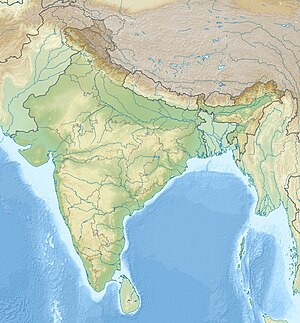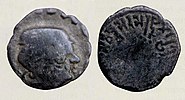| Visvasena | |
|---|---|
  Visvasena coin, and its legend in Brahmi, with a strike date (216) found on the obverse of some coins. The legend reads: Visvasena coin, and its legend in Brahmi, with a strike date (216) found on the obverse of some coins. The legend reads:Rājño Mahākshatrapasa Bhartṛidāmnaḥ putrasa Rājñaḥ Kshatrapasa Viçvasenasa "Of the Rajah and Satrap Visnasena, brother of the Rajah and Great Satrap Bhartrdaman". | |
| Western Satraps | |
| Reign | 293-304 CE |
| Predecessor | Bhartrdaman |
| Successor | Rudrasimha II |
| Father | Rudrasena II |

(Viśvasena coinage)
Viśvasena (Middle Brahmi: ![]() Vi-śva-se-na, r.293–304 CE) was a ruler of the Western Satraps, and the 22nd ruler of the Kshatrapa dynasty. He was the last Kshatrapa ruler of the Chastana family, brother and successor to Bhartrdaman and son of Rudrasena II.
Vi-śva-se-na, r.293–304 CE) was a ruler of the Western Satraps, and the 22nd ruler of the Kshatrapa dynasty. He was the last Kshatrapa ruler of the Chastana family, brother and successor to Bhartrdaman and son of Rudrasena II.
A coin of Visvasena was found in excavations at the Ajanta Caves, in the burnt-brick monastery facing the caves on the right bank of the river Waghora.
His successor was Rudrasimha II.
-
 A coin of Visvasena, found in excavations at Ajanta Caves.
A coin of Visvasena, found in excavations at Ajanta Caves.
References
- Bhagvanlal, Pandit (1834). Journal of the Royal Asiatic Society of Great Britain & Ireland. Cambridge University Press for the Royal Asiatic Society. p. 659.
- Buddhist Landscapes in Central India: Sanchi Hill and Archaeologies of Religious and Social Change, c. Third Century BC to Fifth Century AD, Julia Shaw, Routledge, 2016 p58-59
- "Another queen of Virapurusha was Rudradhara-bhattarika. According to D.C. Sircar she might have been related to Rudrasena II (c. a.d. 254-74) the Saka ruler of Western India" in Rao, P. Raghunadha (1993). Ancient and medieval history of Andhra Pradesh. Sterling Publishers. p. 23. ISBN 9788120714953.
- (India), Madhya Pradesh (1982). Madhya Pradesh District Gazetteers: Ujjain. Government Central Press. p. 26.
- ^ The Cambridge Shorter History of India. CUP Archive. p. 84.
- Mitra, Debala (2004). Ajanta. Archaeological Survey of India. pp. 94-95.
Sources
- K. Krishna Murthy (1977). Nāgārjunakoṇḍā: A Cultural Study. Concept. OCLC 4541213.
| Western Satraps (1st c. CE - 395 CE) | |||
|---|---|---|---|
 |
|  | |